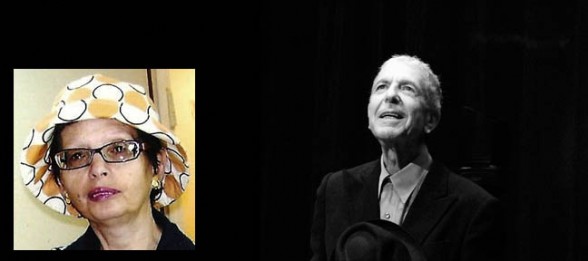Article in PDF (Download)
The High Priest of Song by Natalie Wood
Among the forests of words devoted to the life and work of Canadian singer-songwriter, Leonard Cohen is a website that takes a wry look at his many nicknames.
But I prefer my own – the ‘High Priest of Modern Song’. How else to describe an artistic renaissance figure whose output – like his family name – is informed wholly by his Orthodox Jewish roots?
But how may we also describe a very human individual who’s wedded to his Jewish faith, bolted to his art, but now aged eighty, has never committed to a steadfast relationship with any of his lovers – even the mother of his children? Cohen’s work and life form part of the mental landscape of so many ordinary people, it is difficult to discuss him without being accused of either repetition or cliché. But here, nothing daunted, is my own view of him as a fellow Jew.
The cover image on his latest album, Popular Problems, cuts a lean, lupine figure, dressed as I’ve seen a thousand other elderly Jewish gentlemen, walking gamely to and from synagogue several times during a Sabbath day. So I can imagine his arriving at morning services, then removing his trilby to reveal a skull cap, reciting the traditional blessing as he wraps himself in his prayer shawl and then reading the Ma Tovu prayer – which he also recited at his 2009 concert in Ramat Gan, Tel Aviv, Israel.
But artists don’t think like ordinary mortals! So we have the cerebral and elegiac Cohen wrestling with an erratic, even raffish existence in a private world off-stage.
His Wikipedia entry reminds us how often he has used the Hebrew bible (Torah) and Jewish cultural imagery as sources for his work, citing by example songs like Story of Isaac and Who By Fire and also his second collection of poetry, The Spice-Box of Earth, whose title alludes to the Saturday night rituals performed as the Sabbath concludes. The entry also devotes a separate section to the famous 1984 song, Hallelujah. I venture further that it remains Cohen’s most popular single song because it examines his unending personal struggle – the clash of religious devotion with sexual temptation, symbolised by conflating the two stories of King David and Bathsheba and Samson and Delilah, then blending them most magically with his musical expertise.
Here he gives those new to Jewish thought a look at the distinction between the temporal and divine or ‘the holy and the broken’, as described by music journalist, Alan Light in his book about the song. But there are two further interesting side issues I want to discuss.
The first is Cohen’s involvement in Zen Buddhism and that he sees no split from his Jewish faith but rather that “in the tradition of Zen that I’ve practiced, there is no prayerful worship and there is no affirmation of a deity. So theologically there is no challenge to any Jewish belief”.
The other – superficially – has nothing to do with his Jewish faith but is how he referred to Kelley Lynch, formerly his manager, friend and even briefly his lover after she was jailed for harassing him. They were not the words of a plaintiff but the sermonic admonition of a priest.
Cohen’s florid romantic life is well-documented. He remains unmarried, but while the mother of his children, Susan Elrod is Jewish it seems that Adam, a fellow singer songwriter and Lorca, a photographer and videographer do not take their heritage as seriously as their father. It remains to be seen whether any of Grandpa Leonard’s descendants will be given his mantle to wear.
Meanwhile, even at 80, Cohen continues composing and performing and Popular Problems took only a few weeks to hit No. 1 in 29 countries on the iTunes chart.
© Natalie Wood


